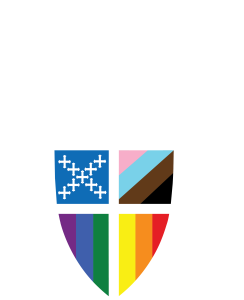Christ Church Parish celebrated its centennial in 1989. It began as the offshoot of an older parish, St. Luke’s Memorial Church (founded in 1882), when that congregation became too large for its downtown sanctuary.
The departing members of St. Luke’s became Trinity Parish and built its chapel several blocks away from both private residences and St. Luke’s. The Trinity sanctuary was initially constructed to seat 300 persons, but by 1917 parish growth made it necessary to enlarge the sanctuary to seat 450. Ironically, in the following decade, dwindling congregations and financial difficulties in both parishes resulted in a brief reunification as Christ Church Parish in 1926. Wells Hall, the parish meeting house, was built in 1927 to serve the two congregations.
When the original St. Luke’s sanctuary was dismantled and rebuilt in north Tacoma in the late 1940s, the two congregations became separated once more. In the post-war era of the 1950s and ’60s, Christ Church flourished. Trinity House (named for the congregation’s earlier identity) was constructed in 1957 to contain a chapel, a columbarium, offices, meeting rooms, classrooms, and a library.
In 1967, the old Tudor Gothic-style church building was declared structurally unsound, and it was decided to completely rebuild our worship space. The new structure, designed by Paul Thiry, AIA, is a modern sanctuary standing in sharp contrast to the traditional rectangular, long-nave building that preceded it. Thiry’s admiration for Le Corbusier’s seminal chapel of Notre-Dame du Haut in Ronchamp, France, is reflected in multiple design and construction elements. The use of plain, poured concrete is its most startlingly modern element. Yet, for all its modernity, the profound simplicity of its interior reflects the solemnity and severity of early Romanesque Christian basilicas.
Wells Hall, Trinity House, and the new sanctuary comprise the physical facilities of Christ Church Parish; together they represented anticipated prosperity and continuing growth. However, that was not to be the case.
In the immediate post-war years, Christ Church was a burgeoning family-oriented congregation, but numerous factors in the ’60s, ’70s, and ’80s changed that. The decades of social concern and unrest, of civil rights marches and anti-Vietnam War protests, nondiscriminatory housing and employment rallies reflected major
concerns of many of our congregants. The capstone of our outreach in this period was the Three Cedars Project. In 1989, Three Cedars was established on nearby church property as an adult family home for AIDS patients. It was the fourth institution of its kind in the state and the only one outside the Seattle area. Welcoming AIDS patients into our congregation and to
our altar was not universally approved of; some families left the parish in response. Others drifted away during the unfortunate rectorships of several less-than-successful leaders. We are now an urban parish with few families and fewer children. While the Children’s Sunday
School program has a number of Zoom-participants from distant parts of the country, we have no young adults, no youth program and no young acolytes for regular services.
Our social life, however, has remained active through the years. We have enjoyed any occasion for a dinner together: Mardi Gras, the Meeting of the Minds, a murder mystery dinner. From fundraisers for international relief to furniture sales for kitchen repair and auctions for almost any cause; from Lenten soup suppers to Bible studies; from pancake breakfasts to “Arts Alive” celebrations, members of Christ Church have supported every occasion to celebrate the life of
Christ in the parish community. But, as leadership waned, celebrations were more and more infrequent until they were halted altogether by the pandemic. At present, the adult formation program and book clubs are significant elements of the intellectual life of our parish.
In the visual arts, the Liturgical Arts Committee takes responsibility for the seasonal decoration of the sanctuary, and the sanctuary is again host to a regular schedule of recitals and concerts.
Many among us have remarkable talents which are gladly shared and greatly appreciated. We are well-educated, we come from a variety of denominations, we have a long history of great vocal and organ music for our weekly services, and we are blessed with a magnificent worship space. We have recently installed equipment for Zoom broadcasts of our services and events. We are optimistic about our gifts and our prospects as we look ahead to our future in the light of God’s continuing grace among us.
